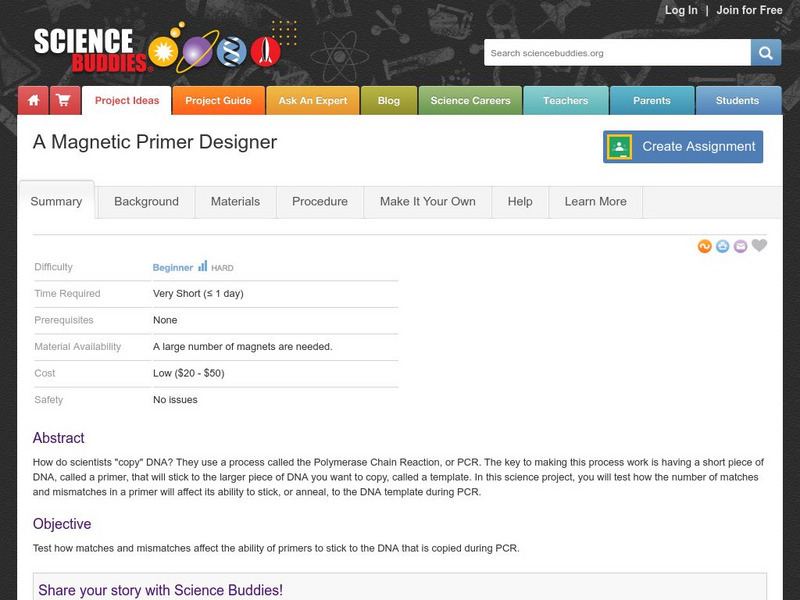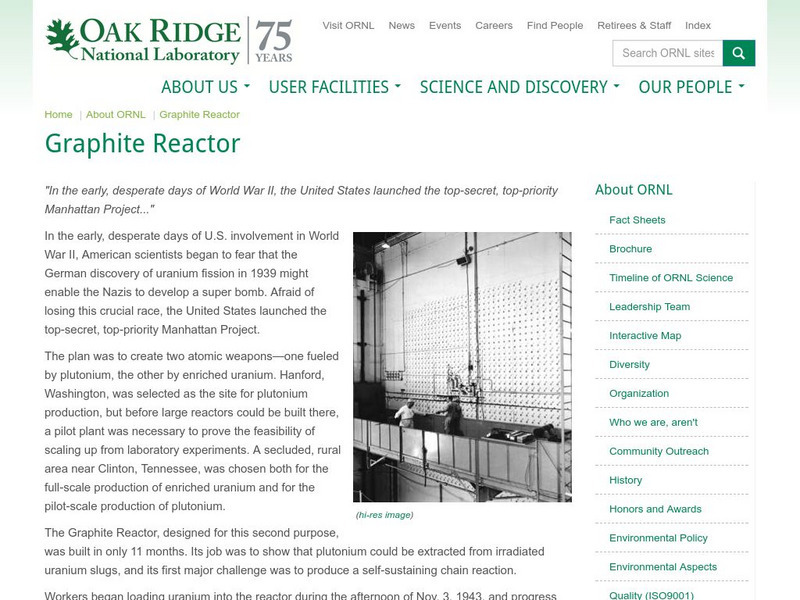Hi, what do you want to do?
American Institute of Physics
Women and the Manhattan Project
The Manhattan Project was a massive undertaking involving multiple sites and thousands of scientists and technicians. To gain an understanding of the women who participated in the project, groups select an oral history of a woman...
American Institute of Physics
African Americans and the Manhattan Project
A lesson about the Manhattan Project will explode young physicists' understanding of the racial attitudes in the United States during and after World war II. Groups select an African American scientist or technician that worked on the...
Curated OER
AP: Chapter 20: DNA Technology
This nine-page biotechnology resource contains six pages of questions regarding DNA technology. Questions cover cloning, restriction enzymes, the polymerase chain reaction, different techniques, the human genome project, and more. The...
Curated OER
Radioactivity, Time, and Age
Four activities demonstrate the chain reaction of nuclear fission to your physical science fans: falling dominoes, snapping mouse traps, throwing paper wads, and igniting a series of matches. They perform additional...
Curated OER
Polymerase Chain Reaction (PCR)
High schoolers explore how PCR works through various activities. In this biology lesson, students explain how PCR generate copies of DNA. They simulate the process using an online interactive website.
Curated OER
Doggy DNA: The Power of PCR
Students listen as the teacher lectures about Polymerase Chain Reaction, and the technical information about its uses. They collect dog saliva and run/analyze a gel electrophoresis. Students use a computer to integrate information, and...
Curated OER
Bouncing Balls
Students create a polymer ball in the lab. In this chemistry lesson, students identify the different properties of the polymer they created. They explain what type of chemical reaction took place.
University City High School
Metabolism Lesson Plan
Not a lesson in the traditional sense, this is a collection of resources with which you can craft a lesson on metabolic processes. It includes an outline of topics, some brief discussion, and a large array of animations, images, and...
Houghton Mifflin Harcourt
Core Analysis Frame: Fiction
Dig into any piece of fiction with a series of analysis questions. There are two levels of questions provided: basic and in-depth. The basic questions can be copied double-sided onto a single piece of paper, while the in-depth questions...
Curated OER
Bouncing Balls
Young scholars create a polymer to demonstrate its properties and develop an awareness of the wide variety of uses for polymers.
Curated OER
Ecosystem In A Bottle
Ecosystem activities show how everyone and everything is interconnected. The smallest change can make a big impact.
Curated OER
Catalase and Catalysis
Students explore enzyme catalysis through a series of experiments. In this chemistry lesson, students determine the factors affecting catalysis. They explain the different uses of this process.
Curated OER
Plankton / Phytoplankton
Young scholars discuss the importance of plankton in the ocean ecosystem. In this biology lesson plan, students identify the different types plankton by observing them under the microscope. They explain how plankton population affect...
Curated OER
Enzymes
Students explore enzymes and what can inhibit and act as a catalyst for them. In this enzymes lesson students complete experiments on enzyme properties.
Curated OER
Ammonium Nitrate- Stoichiometry
High schoolers quantify the relationship between moles and mass. They comprehend that ammonium nitrate is used as a fertilizer and an explosive. Students study the chemistry of ammonium nitrate and consider the advantages and...
Curated OER
To Smell or Not to Smell, That is the Ester
High schoolers explain the basic concepts of polymerization. Students participate in a lab to create a crude preparation of carboxyl esterase and test its effectiveness in reducing the residual monomer in an emulsion such as paint.
Curated OER
Polymerization Experiments
Students explain the process of polymerization. In this chemistry lesson, students produce carboxylesterase in the lab. They test its effectiveness in removing the by-product odor.
The Association of the British Pharmaceutical Industry
Abpi: Human Genome Project
An in-depth look at the human genome project and its scientific and social implications. Students work through interactive learning material, understanding the ethics involved in genetic studies. There is a suggested classroom activity...
Science Buddies
Science Buddies: Chain Reaction: Inversion and the Pappus Chain Theorem
Here is a challenging problem for anyone with an interest in geometry. This project requires background research to solve it, but it is an excellent illustration of visual thinking in mathematics.
Science Buddies
Science Buddies: A Magnetic Primer Designer
How do scientists "copy" DNA? They use a process called the Polymerase Chain Reaction, or PCR. The key to making this process work is having a primer that will stick to the piece of DNA you want to copy, called a template. In this...
Oak Ridge National Laboratory
The Forties: War and Peace
Describes the design of the first nuclear reactor by Enrico Fermi and his successful development of a self-ustaining nuclear chain reaction. Describes the evolution of the Manhattan Project and their race to develop the first atomic...
Oak Ridge National Laboratory
Oak Ridge National Laboratory: The Graphite Reactor
This resource describes the world's first nuclear reactor and the role which it played in the Manhattan Project. Also discussed are topics such as the goal of plutonium development for nuclear weapons, the goals of the top-secret,...
Open Curriculum
Open Curriculum: Dna Technology
This article will help students define DNA technology, the Human Genome Project, and PCR.
Oak Ridge National Laboratory
Oak Ridge National Laboratory: Dna Forensics
A concise explanation of the use of DNA technologies in forensic identification from the Oak Ridge National Laboratory. Additional valuable resources are provided.


























